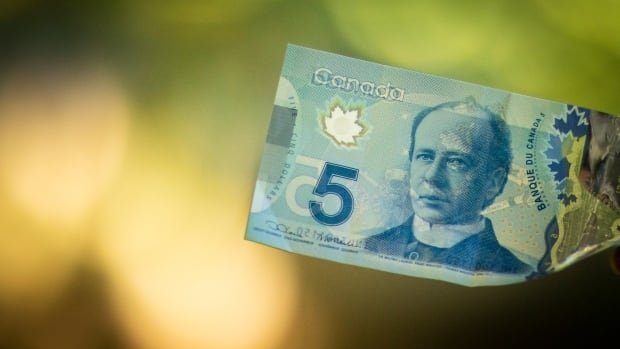Sir Wilfrid Laurier is staying put on the $5 bill — for now
A Canadian five dollar bill bank note is pictured in Vancouver, British Columbia on Friday, July 14, 2023. Nearly three years ago, the Bank of Canada announced a plan to remove Sir Wilfrid Laurier from the $5 bill and replace him with someone else from the country's past. The process has since stalled. (Ben Nelms/CBC)Nearly three years ago, the Bank of Canada announced a plan to remove from the $5 bill the face of Sir Wilfrid Laurier — the only French-Canadian prime minister on a banknote — and replace him with someone else from the country's past.But the effort to swap out one of the most consequential leaders in the country's history for a less well-known figure from a diverse shortlist of eight possible candidates has since stalled.The Bank of Canada, the independent central bank, started the consultation process that produced the short list. Under law, the federal finance minister makes the final call on who appears on Canada's hard currency."The current $5 note with depictions of


Nearly three years ago, the Bank of Canada announced a plan to remove from the $5 bill the face of Sir Wilfrid Laurier — the only French-Canadian prime minister on a banknote — and replace him with someone else from the country's past.
But the effort to swap out one of the most consequential leaders in the country's history for a less well-known figure from a diverse shortlist of eight possible candidates has since stalled.
The Bank of Canada, the independent central bank, started the consultation process that produced the short list. Under law, the federal finance minister makes the final call on who appears on Canada's hard currency.
"The current $5 note with depictions of Sir Wilfrid Laurier and Canadarm2 and Dextre (Canadian robotics innovations in space) will continue to circulate for some time," a Bank of Canada spokesperson said in a media statement to CBC News.
"As banknote portrait subjects are the minister of finance's decision, we are not in a position to comment further."
A spokesperson for Finance Minister Chrystia Freeland declined to comment on the process or whether the minister is keen on a change.
A spokesperson for the Department of Finance said they had nothing new to report.
"The government welcomed the ideas and suggestions from many Canadians who nominated candidates for the $5 banknote. The next steps are being considered at this time," a finance official said.
The process to remove Sir John A. Macdonald from the $10 bill, meanwhile, unfolded over the course of a single year. He was replaced by the Nova Scotia-born civil rights activist Viola Desmond.
In 2016, the Bank of Canada surveyed Canadians on dropping the first prime minister from the banknote. It gathered suggestions from the public and appointed an independent advisory council to narrow down the list.
Bill Morneau, the finance minister at the time, approved Macdonald's replacement. Desmond's name was announced in December and the new bills were rolled out in 2018.
The bank said at the time that Macdonald and Laurier could end up on "higher-value bank notes" when they are eventually redesigned.
The bank initiated the process of replacing Laurier's face in January 2020 by compiling a list of hundreds of eligible nominees. An advisory board winnowed down the list.
The final shortlist was unveiled in November and sent off to Freeland for a decision. Three years later, there hasn't been any apparent progress.
The bank's list of ethnically and racially diverse candidates to replace Laurier on the $5 bill include Inuit printmaker Pitseolak Ashoona, journalist Robertine Barry, Indigenous rights advocate and First World War hero Binaaswi (Francis Pegahmagabow), Chinese-Canadian activist Won Alexander Cumyow, national icon and athlete Terry Fox, Czech-born humanitarian Lotta Hitschmanova, Siksika chief Issapomahksika (Crowfoot) and Mohawk leader and soldier Onondeyoh (Frederick Ogilvie Loft).
Apart from Fox — a household name — the other candidates are not widely known.

Barry, born in Quebec, is the only French-Canadian on the shortlist.
Historian and former speechwriter Arthur Milnes is the editor of Canada Always: The Defining Speeches of Sir Wilfrid Laurier.
Milnes said the government's heel-dragging on a replacement for Laurier is a welcome development — he doesn't want to see Canada's 7th prime minister scrapped at all.
"I think folks in the future are going to look back on this and scratch their heads. We're trying to hide these two great men. What's the endgame?" he told CBC News.
"I'm sorry, no John Macdonald, no Wilfrid Laurier, no Canada."
He said Macdonald and Laurier undoubtedly "had their faults" — including their racist and dehumanizing policies on Indigenous peoples and racial minorities — but it's wrong to erase them from the public sphere.
"Canada exists as a distinct nation on the northern half of the continent because of these two," he said.
"If anything, we need to know more about these prime ministers to understand our country and our national story — not less."

He said that while the bank's quest to diversify the faces on Canada's currency is a noble one, it shouldn't come at the expense of the country's founders.
And a move to ditch Laurier and replace him with a non-francophone figure could prompt a backlash and threaten national unity, he said.
Multiple polls suggest Canadians' knowledge of their own history is dismal. Many know very little about leaders like Macdonald and Laurier, except for their perceived failings.
Macdonald united the British North American colonies in Confederation and built the transcontinental railway that stitched together a fledgling country — an infrastructure project that also was meant to serve as a bulwark against American annexation.
Laurier dramatically expanded immigration to help settle Western Canada and worked to foster national unity by balancing English and French interests.
"I'm eager to learn about new figures, of course I am. But we also have to learn the basics and right now, we're on a quest to hide them because some of it is unsettling for us today. That's too bad," Milnes said.
Alastair Gillespie is a senior fellow at the Macdonald-Laurier Institute and an expert on Canada's political traditions.
He said the banknote debate should not be an "either-or" situation.
The country can keep Laurier and "make room for other great Canadians and new stories" on the money.
"Laurier is the sort of Canadian you want to memorialize. His whole career was about fostering Canadianism and cohesion and mastering the conflict amongst English- and French-speaking Canadians and creating imperfect compromises. He was a Canadian, first, last and always," Gillespie told CBC News.
"If you value the Canadian state, the idea that there should be a Canada, then it's essential for Laurier to be remembered, not necessarily set on a pedestal without criticism, but he certainly shouldn't be erased," he said.

There may be a way to satisfy everyone, Gillespie said. The bank could feature lesser-known "very worthy" heroes from Canada's history while preserving a prominent place for the founding fathers, he said.
There are five bills, each with two sides — enough real estate for a dual focus.
"Bank notes, when they pass through Canadians' hands every day, they're symbols and they're teachers and they communicate something about who we are. And a little bit of change now and again is a good thing," he said.
"We would be proud to have any of the nominees appear on the bill. But we ought to keep Laurier. There's room for him and somebody new."
What's Your Reaction?

















